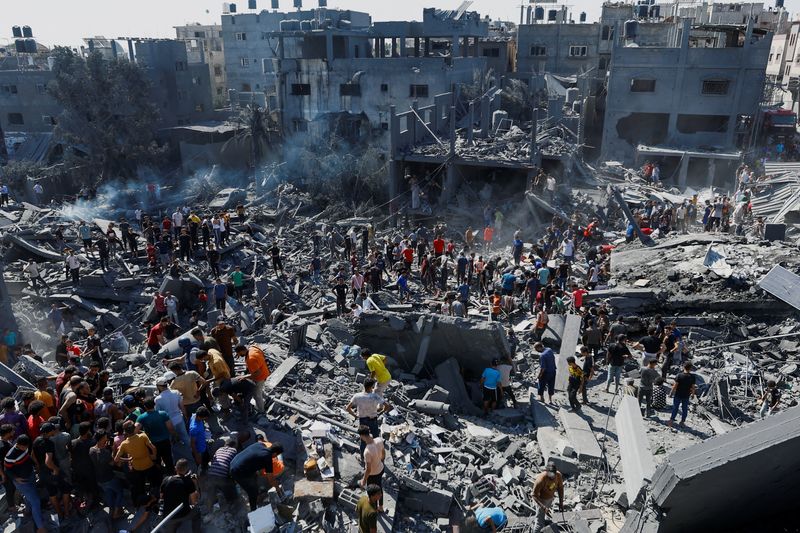Despite Biden’s doubts, humanitarian agencies consider Gaza toll reliable
2023.10.27 07:40

© Reuters. Palestinians search for casualties at the site of Israeli strikes on houses, as the conflict between Israel and Palestinian Islamist group Hamas continues, in Khan Younis in the southern Gaza Strip, October 26, 2023. REUTERS/Ibraheem Abu Mustafa
By Gabrielle Tétrault-Farber
GENEVA (Reuters) – U.S. President Joe Biden has cast doubt on casualty figures provided by Palestinian officials in Gaza, but international humanitarian agencies consider them broadly accurate and historically reliable.
Although there is no dispute that Israeli attacks on Gaza have killed many people since Hamas ran amok in southern Israel on Oct. 7, Biden said on Wednesday he had “no confidence in the number that the Palestinians are using”, without saying why.
The health ministry in Hamas-controlled Gaza responded by releasing a 212-page document containing the names and identity numbers of around 7,000 Palestinians it said had been killed in the Israeli bombardment of the enclave.
International groups, even some operating in Gaza, and global media including Reuters are not able to verify the figures but reporters have seen large numbers of bodies.
U.N. and other international agencies say there can be small discrepancies between the final casualty numbers and those reported by the Gaza health ministry straight after attacks, but that they broadly trust them.
“We continue to include their data in our reporting and it is clearly sourced,” the U.N. Office for the Coordination of Humanitarian Affairs (OCHA) said in a statement to Reuters.
“It is nearly impossible at the moment to provide any UN verification on a day-to-day basis.”
Dr Mike Ryan, Executive Director of the Geneva-based World Health Organization’s Health Emergencies Programme, said last week figures released by both sides “may not be perfectly accurate on a minute-to-minute basis, but they grossly reflect the level of death and injury on both sides of that conflict.”
New York-based Human Rights Watch also says the casualty figures have generally been reliable, and that it has not found big discrepancies in its verification of past strikes on Gaza.
“It’s worth noting that the numbers that are coming out since October 7th are generally consistent or within logic for the scale of killings one would expect, given the intensity of bombardment in such a densely populated area,” Omar Shakir, Israel and Palestine Director at Human Rights Watch, said.
“Those numbers are in line with what one might expect, given what we’re seeing on the ground through testimony, through satellite imagery and otherwise,” he told Reuters.
FIGURES BROADLY ALIGN
Underlining the difficulties in calculating death tolls, a World Health Organization official said on Friday the agency had received estimates that some 1,000 unidentified bodies were still buried under the rubble in Gaza and not yet included in death tolls. The official did not specify the source.
While Hamas controls Gaza and exercises tight control over information coming out of the enclave, formal responsibility for the health ministry still rests with the Palestinian Authority (PA) in the West Bank.
The PA is dominated by Fatah, the main Palestinian rival to Hamas, and is responsible for paying salaries and providing equipment to Gaza hospitals.
It reports casualty totals based on numbers it receives from hospitals, ambulances and emergency services, in coordination with the Red Crescent, a spokesman in Ramallah said.
He said victims are initially identified by age, sex and injury type, and full identities are confirmed later. The figures are initially reported in Gaza, and updated in Ramallah after they have been checked, but discrepancies are generally minimal, he said.
Israel has not provided its own estimated death toll.
There has been no big change in the way Palestinian authorities report casualties since the last big conflict between Israel and Hamas in 2014, when figures provided by various entities were not vastly different.
In a report published on its website on Nov. 3, 2015, the Palestinian health ministry said the number of people killed in the July-August 2014 conflict in Gaza was 2,322.
A U.N.-mandated commission of inquiry reported that 2,251 Palestinians had been killed.
Although Israel blamed Hamas for the majority of the deaths in Gaza, the Israeli Foreign Ministry said in a report following the conflict that 2,125 Palestinians had been killed in Gaza, according to data gathered by the Israeli military.
The Jerusalem Center for Public Affairs, an Israeli think tank, said more than 2,100 Palestinians were killed, while rights groups B’tselem put that figure at 2,202 Palestinians.
ISRAELI CONCERN
Israel has been attacking Gaza since cross-border raids in which it said 1,400 people were killed by Hamas in southern Israel. Biden, who was speaking at a press conference, did not explain on Wednesday why he lacked confidence in the casualty figures provided by the Palestinians.
An Israeli military spokesman said this week the Gaza health ministry “continuously inflates the number of civilian casualties” and “has been caught lying in the past”.
He cited the ministry’s handling of an attack at Al-Ahli al-Arabi Hospital in Gaza on Oct. 17 which each side blamed on the other, saying the ministry initially reported 500 dead but later revised the toll down to 471. In a separate media briefing, another spokesman gave no Israeli casualty estimate when asked by reporters what Israel assessed the overall total to be.
An unclassified U.S. intelligence report seen by Reuters estimated the death toll in the hospital attack was “probably at the low end of the 100 to 300 spectrum”. An Israeli official has said the toll appears to be “several dozen”.
Palestinian officials said calculating the number of dead in the attack had been difficult because some victims were dismembered, meaning there were many body parts to identify.








